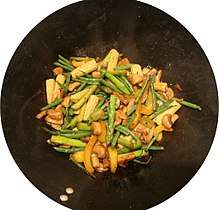Baby corn

Baby corn (also known as young corn, cornlets or baby sweetcorn) is a cereal grain taken from corn (maize) harvested early while the stalks are still small and immature. It typically is eaten whole – cob included – in contrast to mature corn, whose cob is too tough for human consumption. It is eaten both raw and cooked. Baby corn is common in stir fry dishes.
Production methods
There are two methods for producing baby corn either as a primary crop or as a secondary crop in a planting of sweet corn or field corn. In the first method, a seed variety is chosen and planted to produce only baby corn.[1] Many varieties are suitable, but those developed specifically for baby corn tend to produce more ears per plant. In the second production method, the variety is selected to produce sweet or field corn. The second ear from the top of the plant is harvested for baby corn, while the top ear is allowed to mature.[2]
Baby corn ears are hand-picked as soon as the corn silks emerge from the ear tips, or a few days after. Corn generally matures very quickly, so the harvest of baby corn must be timed carefully to avoid ending up with more mature corn ears. Baby corn ears are typically 4.5 to 10 cm (1.8–3.9 in) in length and 7 to 17 mm (0.28–0.67 in) in diameter.[2]
Uses
Baby corn is consumed worldwide.[3] Its production has increased from 239.7 to 279.7 million tonnes from 2003 to 2013.[4]
Baby corn forage can also be fed fresh or ensiled to livestock animals.[3][5]
References
- ↑ Corn Pollination and Fertilization (PDF), Gold Country Seed
- 1 2 Miles, Carol A.; Zenz, Leslie (May 2000). "Baby Corn" (PDF). Pacific Northwest Extension Publication PNW0532. Retrieved 2011-10-16.
- 1 2 Heuzé V., Tran G., Edouard N., Lebas F., 2017. Maize green forage. Feedipedia, a programme by INRA, CIRAD, AFZ and FAO. Last updated on June 21, 2017, 10:16
- ↑ Mohinder P.S. Bakshi, M. Wadhwa and Harinder P.S. Makkar, 2017: Utilization of baby corn by-products and waste as livestock feed, Broadening Horizons N° 44
- ↑ Heuzé V., Tran G., Edouard N., Lebas F., 2017. Maize silage. Feedipedia, a programme by INRA, CIRAD, AFZ and FAO. Last updated on June 22, 2017, 14:24
External links
- What is Baby Corn? Pamphlet From Washington State University
